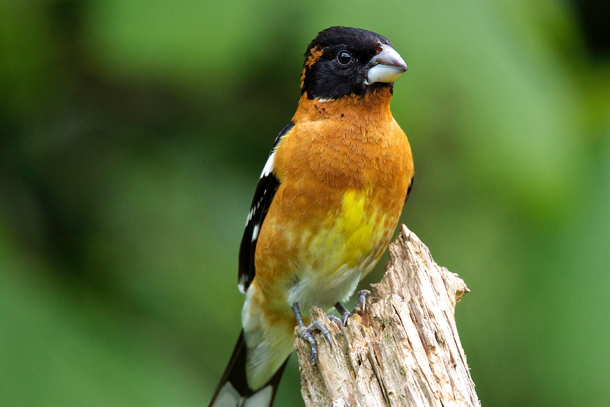BirdNote®: How Much Birds Sing
Air Date: Week of June 26, 2015

Black-headed Grosbeak (Photo: Jerry McFarland)
Worldwide, songbirds sing to claim territory and protect mates, but each species does it with its own style. Some tweet a short phrase and others warble on and on. As BirdNote’s Michael Stein reports, some species want to make sure their message is heard, singing thousands of times a day.
Transcript
CURWOOD: It's Living on Earth. I'm Steve Curwood. If you’re an early riser or have trouble sleeping, you’ll notice that some birds are already singing fit to beat the band in the dark hours before dawn — which, around now, close to the summer solstice, can be very early indeed in parts of the country. But as Michael Stein explains in today’s BirdNote®, many different factors affect when and how much birds actually sing.
[MUX - BIRDNOTE® THEME]
BIRDNOTE®/HOW MUCH BIRDS SING
[Black-headed Grosbeak song]
This rollicking song belongs to a Black-headed Grosbeak. [Black-headed Grosbeak song] Like most birds, the male grosbeak begins singing in earnest a few days after reaching his traditional nesting grounds in spring. [Black-headed Grosbeak song] And, like most birds, he sings frequently when trying to attract a mate. He’ll sing a bit less while he and his mate incubate eggs, but pick up the pace again after the young hatch. [Black-headed Grosbeak song] By late summer, his singing will cease.
Ever wonder how much a bird sings in one day? Some patient observers have shown that a typical songbird belts out its song between 1,000 and 2,500 times per day. Even though most bird songs last only a few seconds, that’s a lot of warbling!

Sage Thrasher (Photo: Bob Devlin)
On nights with a full moon, male Sage Thrashers have been known to proclaim
their long-winded songs all night. [Sage Thrasher song] But the North American record-holder may well be the Red-eyed Vireo. One such vireo delivered its short song over 22,000 times in ten hours! [Red-eyed Vireo song]
###
Written by Bob Sundstrom
Bird sounds provided by The Macaulay Library at the Cornell Lab of Ornithology, Ithaca, New York. Song of the Black-headed Grosbeak 126546 recorded by T.G. Sander; song of Sage Thrasher 120223 recorded by G.A. Keller; song of the Red-eyed Vireo 110208 recorded by W.L. Hershberger.
Producer: John Kessler
Executive Producer: Chris Peterson
© 2015 Tune In to Nature.org June 2015 Narrator: Michael Stein
Images:
Black-headed Grosbeak © Jerry McFarland https://www.flickr.com/photos/56509109@N04/18103573032
Sage Thrasher © Bob Devlin http://www.njaudubon.org/SectionCenters/SectionSHBO/SandyHookRarities.aspx
Red-eyed Vireo © Kenneth Cole Schneider https://www.flickr.com/photos/rosyfinch/5014856909
http://birdnote.org/show/how-much-birds-sing

Red-eyed Vireo (Photo: Kenneth Cole Schneider)
CURWOOD: You can find photos of some of these champion songsters at our website, LOE.org.
[BIRDSONG]
Links
BirdNote®’s “How Much Birds Sing”
Living on Earth wants to hear from you!
Living on Earth
62 Calef Highway, Suite 212
Lee, NH 03861
Telephone: 617-287-4121
E-mail: comments@loe.org
Newsletter [Click here]
Donate to Living on Earth!
Living on Earth is an independent media program and relies entirely on contributions from listeners and institutions supporting public service. Please donate now to preserve an independent environmental voice.
NewsletterLiving on Earth offers a weekly delivery of the show's rundown to your mailbox. Sign up for our newsletter today!
 Sailors For The Sea: Be the change you want to sea.
Sailors For The Sea: Be the change you want to sea.
 Creating positive outcomes for future generations.
Creating positive outcomes for future generations.
 Innovating to make the world a better, more sustainable place to live. Listen to the race to 9 billion
Innovating to make the world a better, more sustainable place to live. Listen to the race to 9 billion
 The Grantham Foundation for the Protection of the Environment: Committed to protecting and improving the health of the global environment.
The Grantham Foundation for the Protection of the Environment: Committed to protecting and improving the health of the global environment.
 Contribute to Living on Earth and receive, as our gift to you, an archival print of one of Mark Seth Lender's extraordinary wildlife photographs. Follow the link to see Mark's current collection of photographs.
Contribute to Living on Earth and receive, as our gift to you, an archival print of one of Mark Seth Lender's extraordinary wildlife photographs. Follow the link to see Mark's current collection of photographs.
 Buy a signed copy of Mark Seth Lender's book Smeagull the Seagull & support Living on Earth
Buy a signed copy of Mark Seth Lender's book Smeagull the Seagull & support Living on Earth

